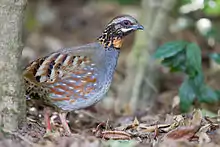Rufous-throated partridge
The rufous-throated partridge (Arborophila rufogularis) is a species of bird in the family Phasianidae. It is found in montane forests in India and Southeast Asia. The International Union for Conservation of Nature (IUCN) has assessed it as a least-concern species.
| Rufous-throated partridge | |
|---|---|
 | |
| Scientific classification | |
| Kingdom: | Animalia |
| Phylum: | Chordata |
| Class: | Aves |
| Order: | Galliformes |
| Family: | Phasianidae |
| Genus: | Arborophila |
| Species: | A. rufogularis |
| Binomial name | |
| Arborophila rufogularis | |
| Synonyms | |
|
Arboricola rufogularis Blyth, 1849 | |
Taxonomy
This species was described by Blyth in 1849. Six subspecies are recognised: A. r. rufogularis found in northeastern India, Nepal, Bhutan and southeastern Tibet; A. r. intermedia ranging from northeastern India to northern Myanmar; A. r. tickelli in eastern Myanmar, Thailand and southwestern Laos; A. r. euroa in southeastern Yunnan and northern Laos; A. r. guttata in central Vietnam and central Laos; and A. r. annamensis in south central Vietnam.[3]
Description
The rufous-throated partridge is 26–29 cm (10–11 in) long. The male weighs 325–430 g (11.5–15.2 oz) and the female weighs 261–386 g (9.2–13.6 oz). The male has a grey forehead. The olive-brown crown and nape have black mottles. There are a whitish supercilium and moustachial curves. The throat and neck-sides are orange-rufous, with black speckles. The breast and flanks are blue-grey. The upper belly is blue-grey and the central belly is whitish. The vent is buffy-brown. The mantle, back and rump are olive-brown. The scapulars and wing coverts have chestnut, black and greyish bands. The beak is dusky-brown or blackish, and the legs are pinkish or crimson. The female is similar to the male. The juvenile bird is duller below, and its crown and flanks have brown and black vermiculations. The subspecies have different patterns on their throats.[4]
Distribution and habitat
The rufous-throated partridge is found in Bangladesh, Bhutan, China, India, Laos, Myanmar, Nepal, Thailand, and Vietnam.[1] Its natural habitat is montane forests, mainly at elevations of 1,800–3,000 metres (5,900–9,800 ft). Oak forests containing laurels and rhododendrons are preferred.[4]
Behaviour
This partridge feeds in groups of five to ten birds. It eats seeds, plant shoots, berries, insects and snails. Surprised birds run or fly, sometimes flying to branches like some thrushes. Birds in a covey roost and huddle together in trees, similar to babblers.[4] Breeding has been recorded from April to July in India and from February to May in China. The male builds a scrape in bamboo, forest undergrowth or along water. The nest is lined or padded with grass. Three to five white eggs are laid.[4] The rufous-throated partridge gives a rising series of hu-hu whistles. In a duet, the partner's call is kew-kew-kew.[5]
Status
The IUCN estimates that the species's population is declining because of habitat destruction and unsustainable hunting, but the decline is not rapid, and the range is large, so the IUCN has assessed it as a least-concern species.[1]
References
- BirdLife International (2016). "Arborophila rufogularis". IUCN Red List of Threatened Species. 2016: e.T22679020A92798815. doi:10.2305/IUCN.UK.2016-3.RLTS.T22679020A92798815.en.
- Blyth, E. (1849). "A Supplemental Note to the Catalogue of the Birds in the Asiatic Society's Museum". The Journal of the Asiatic Society of Bengal. 18: 800–821, 819.
- Gill, F.; Donsker, D. (eds.). "Pheasants, partridges & francolins". IOC World Bird List Version 7.2. Retrieved 6 July 2017.
- Madge, Steve; McGowan, Phil (2010). Pheasants, Partridges & Grouse: Including buttonquails, sandgrouse and allies. Bloomsbury. pp. 255–256. ISBN 9781408135655.
- MacKinnon, John; Phillipps, Karen (2000). A Field Guide to the Birds of China. Oxford University Press. p. 38. ISBN 9780198549406.
